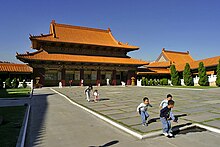| San Gabriel Valley | |||||||||||||||
|---|---|---|---|---|---|---|---|---|---|---|---|---|---|---|---|
 Hsi Lai Temple in Hacienda Heights, the second-largest Buddhist temple and monastery in the Western hemisphere. | |||||||||||||||
| Simplified Chinese | 圣盖博谷 | ||||||||||||||
| Traditional Chinese | 聖蓋博谷 | ||||||||||||||
| |||||||||||||||
| Alternative Chinese name | |||||||||||||||
| Simplified Chinese | 圣加布里埃尔谷 | ||||||||||||||
| Traditional Chinese | 聖加布里埃爾谷 | ||||||||||||||
| |||||||||||||||
| Second alternative Chinese name | |||||||||||||||
| Simplified Chinese | 圣加百利谷 | ||||||||||||||
| Traditional Chinese | 聖加百利谷 | ||||||||||||||
| |||||||||||||||
The Asian American influx into the southwestern portion of the San Gabriel Valley region of Los Angeles County, California, grew rapidly when Chinese immigrants began settling in Monterey Park in the 1970s. Just east of the city of Los Angeles, the region has achieved international prominence as a hub of overseas Chinese, or hua qiao.[1][2] Although Chinese immigrants were a noteworthy presence in the establishment of Southern California from the 19th century, significant Chinese migration to suburban San Gabriel Valley coincided with a trend of white out-migration from the 1970s onward.[3] This opened an opportunity for middle-class Asian Americans to begin settling in the San Gabriel Valley.[4]
High property values, crime, and overcrowding in Monterey Park[5] have contributed to a secondary movement away from that city, and the Chinese community is now spread over a cluster of cities in the San Gabriel Valley. Suburban cities in the valley besides Monterey Park with large Chinese populations, also called ethnoburbs, include Alhambra, Arcadia, Rosemead, San Marino, San Gabriel, South Pasadena, and Temple City and then eastward to Chino Hills, Diamond Bar, the City of Industry, Hacienda Heights, Rowland Heights, Walnut, and West Covina.[1] Numerous Mandarin, Hokkien, Hakka, Teochew, Shanghainese, and Cantonese speaking businesses have been established in these suburbs to accommodate the changing population.
- ^ a b Reckard, E. Scott and Khouri, Andrew (March 24, 2014) "Wealthy Chinese home buyers boost suburban L.A. housing markets" Los Angeles Times
- ^ Shyong, Frank (February 12, 2014). "Chinese visitors turning San Gabriel into a boomtown". Los Angeles Times. Archived from the original on February 13, 2014.
- ^ Berton, Justin (January 7, 2011). "Whites in state 'below the replacement' level". The San Francisco Chronicle.
- ^ Horton, John. The Politics of Diversity: Immigration, Resistance, and Change in Monterey Park, California . Temple University Press, 195. p. 80. Chapter 4
- ^ "City of Monterey Park : Housing Needs". Archived from the original on July 17, 2011. Retrieved January 21, 2011.